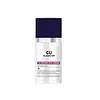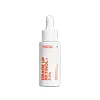What's inside
What's inside
 Key Ingredients
Key Ingredients

 Benefits
Benefits

 Concerns
Concerns

 Ingredients Side-by-side
Ingredients Side-by-side

Water
Skin ConditioningGlycerin
HumectantGlyceryl Glucoside
HumectantAlcohol
AntimicrobialNiacinamide
SmoothingCetearyl Alcohol
EmollientHydrogenated Polydecene
EmollientCaprylic/Capric Triglyceride
MaskingButylene Glycol
HumectantCyclohexasiloxane
EmollientTriethyl Citrate
MaskingEthyl Macadamiate
Skin ConditioningEel Extract
HumectantLactobacillus/Punica Granatum Fruit Ferment Extract
Skin ConditioningSaccharomyces/Barley Seed Ferment Filtrate
HumectantLactobacillus/Pear Juice Ferment Filtrate
Skin ConditioningCeramide NP
Skin ConditioningCeramide Ns
Skin ConditioningCeramide As
Skin ConditioningCeramide AP
Skin ConditioningCeramide EOP
Skin ConditioningCholesterol
EmollientAllantoin
Skin ConditioningPropanediol
SolventPolyglyceryl-3 Methylglucose Distearate
EmulsifyingSorbitan Olivate
EmulsifyingGlyceryl Stearate
EmollientLecithin
EmollientHydrogenated Lecithin
EmulsifyingSorbitan Isostearate
EmulsifyingCaprylyl/Capryl Glucoside
CleansingSorbitan Oleate
EmulsifyingAcrylates Copolymer
Hydroxyethyl Acrylate/Sodium Acryloyldimethyl Taurate Copolymer
Emulsion StabilisingDimethicone/Vinyl Dimethicone Crosspolymer
Skin ConditioningSodium Acrylate/Sodium Acryloyldimethyl Taurate Copolymer
Emulsion StabilisingPolyisobutene
Glyceryl Acrylate/Acrylic Acid Copolymer
HumectantDipropylene Glycol
HumectantPentylene Glycol
Skin ConditioningMannan
Vinyldimethicone
Beeswax
Emulsion StabilisingWater, Glycerin, Glyceryl Glucoside, Alcohol, Niacinamide, Cetearyl Alcohol, Hydrogenated Polydecene, Caprylic/Capric Triglyceride, Butylene Glycol, Cyclohexasiloxane, Triethyl Citrate, Ethyl Macadamiate, Eel Extract, Lactobacillus/Punica Granatum Fruit Ferment Extract, Saccharomyces/Barley Seed Ferment Filtrate, Lactobacillus/Pear Juice Ferment Filtrate, Ceramide NP, Ceramide Ns, Ceramide As, Ceramide AP, Ceramide EOP, Cholesterol, Allantoin, Propanediol, Polyglyceryl-3 Methylglucose Distearate, Sorbitan Olivate, Glyceryl Stearate, Lecithin, Hydrogenated Lecithin, Sorbitan Isostearate, Caprylyl/Capryl Glucoside, Sorbitan Oleate, Acrylates Copolymer, Hydroxyethyl Acrylate/Sodium Acryloyldimethyl Taurate Copolymer, Dimethicone/Vinyl Dimethicone Crosspolymer, Sodium Acrylate/Sodium Acryloyldimethyl Taurate Copolymer, Polyisobutene, Glyceryl Acrylate/Acrylic Acid Copolymer, Dipropylene Glycol, Pentylene Glycol, Mannan, Vinyldimethicone, Beeswax
Ingredients Explained
These ingredients are found in both products.
Ingredients higher up in an ingredient list are typically present in a larger amount.
This ingredient is an emollient, solvent, and texture enhancer. It is considered a skin-softener by helping the skin prevent moisture loss.
It helps thicken a product's formula and makes it easier to spread by dissolving clumping compounds.
Caprylic Triglyceride is made by combining glycerin with coconut oil, forming a clear liquid.
While there is an assumption Caprylic Triglyceride can clog pores due to it being derived from coconut oil, there is no research supporting this.
Learn more about Caprylic/Capric Triglyceride